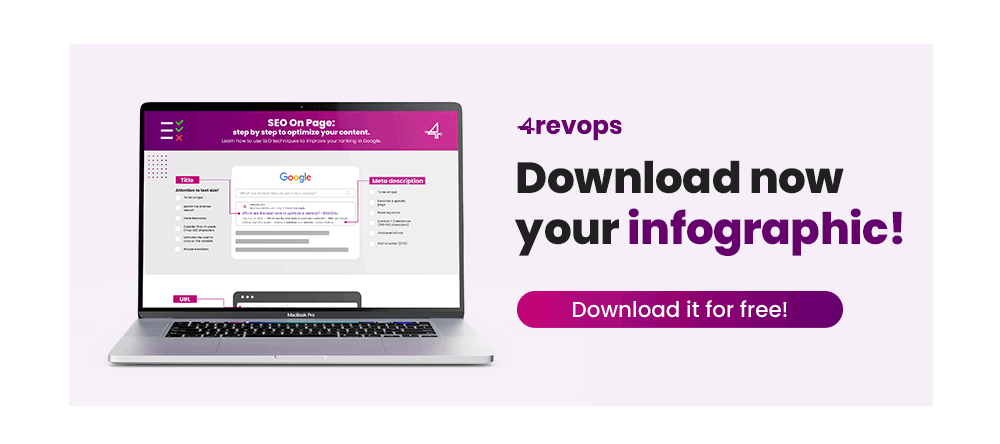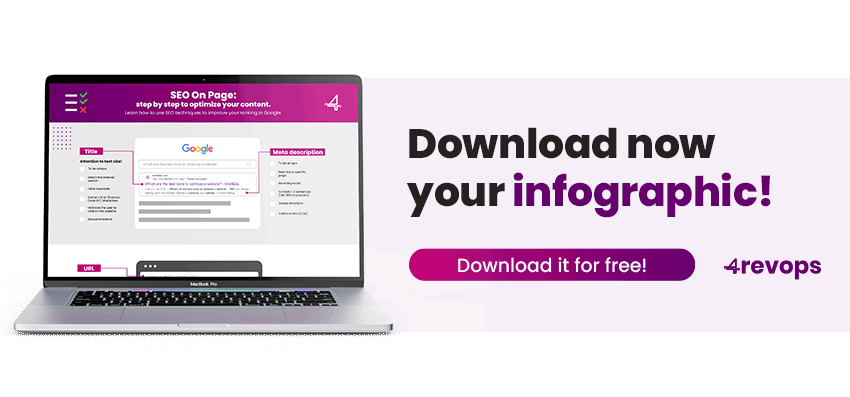If you work with content creation, you know well that one of the biggest challenges is getting your blog featured in search engines. But to rank your page, SEO training can make this mission a lot easier.
With that in mind, today, we prepared more than a blog post, this is a “free seo course” for you who want to increase your traffic to your site. Continue reading and discover, step by step, how to reach the first pages of Google.
In this post, you will find:
- The Importance of the First Page of Google
- What is ON Page SEO?
- What is the difference between On Page and Off Page SEO?
- What is the importance of SEO ON Page?
- Step by step on how to do SEO ON Page;
- page title;
- meta description;
- URL;
- Header 1;
- Images;
- body text;
- Linkagem;
- Subtitles;
- lists;
- Video;
- read more.
But before putting SEO techniques into practice, it's important that you thoroughly understand the behavior of your target audience in the virtual environment, and that's what we're going to talk about in the first topic.
The Importance of the First Page of Google
When you want to find something on the Internet, you usually turn to Google, am I right? In fact, search engines are used by thousands of people every day to find the answer they need more easily.
Faced with so many results provided by Google, 75% of users tend to click only on the contents that are in the first pages, as shown by a study done by Hubspot.
Still, according to another survey carried out by Sistrix, the first result of the mechanisms of search has a click rate of 28.5%. The second and third option fall significantly in the results, with rates of 15% and 11%, respectively
But how to reach the first page of search engines? The answer is SEO.
With users increasingly restricting themselves to the first few pages, your site needs the best SEO techniques to be found more easily.In this mission, an important duo can help you: theSEO ON Page e Off Page.
Both need to work towards building a strong site with a focus on performing well. But after all,what is an SEO ON page? Next, we will explain one of the optimization techniques.
What is ON Page SEO?
In short, THIS On Site or ON Page is a set of techniques made by seo experts focused on optimizing the contents from your website.
Do you know when you put a keyword in the title or organize your post in subtitles like this? These are practices of a good SEO ON Page.
That is, everything that is inside from your blog, from image descriptions, internal links or even the URL of your post — important items for SEO ON page — all this, is optimized to increase the performance of your page.
What is the difference between On Page and Off Page SEO?
For those who are starting to implement optimization techniques, this is a common question. After all, what changes between On Page and Off Page SEO?
Unlike On Page SEO, which works on everything inside your blog, Off Page SEO strategies focus on everything outside your page to increase your site's authority.
What is the importance of SEO ON Page?
Who is not seen is not remembered, this popular saying fits very well when it comes to the Internet! It is not enough just to publish content or be "online", it is necessary to appear in search engines to be seen by users.
At that point, with marketing strategies and On Page SEO tactics, you increase your visibility and attract more visitors to your page.
But this is not the only benefit of putting THIS. In addition to generating the dreamed organic traffic to your page, ON Page techniques can improve the user experience.
Not to mention that strategies can help your company reach a qualified audience and also add credibility to your brand. Between us, who doesn't want all that for their page?
Additionally, with the rise of generative AI and voice search, SEO needs to consider Answer Engine Optimization (AEO). This concept focuses on structuring content so that it can be easily used by assistants like Google SGE and ChatGPT, answering questions accurately. Working with optimized snippets and objective answers can guarantee more clicks, even in zero-click searches.
But to achieve such benefits, it is necessary to put into practice the techniques of SEO ON Page for website optimization, and that's what we're going to talk about next.
Step by step on how to do SEO ON Page
Let's talk about SEO in practice? If you started investing in your digital marketing strategies and were wondering how to optimize a blog, in this topic, we will teach you step by step how to do SEO ON Page. Come on?
Page title
The first step to start optimizing your website is to think of a good title. This is one of the most important elements for SEO ON Page.
It is through it that you can describe, in a few words, the subject of your content. Keep in mind that this title is what appears on the Google page, so it needs to attract your reader. Remember, too, that this is not necessarily the title of your blog, okay?
At this point, your page title needs to elicit emotions from your target audience, be unique, and contain a keyword.
In addition, this text must be succinct, with a maximum of 60 characters, since this is the limit that tends to appear in the results on a search page, and no one wants your title to be viewed with some cut, right?

Caption: Simple adjustments, powerful results: check out the essential On Page SEO items that cannot be missing from your strategy!
Meta description
If you really want to learn SEO, it's time to think about your meta description or meta description. In practice, the “goal” is that summary that appears just below the title when the user finds your page in the search engine.
Despite the small amount of characters, make no mistake, the meta description can be decisive for the user to choose whether or not to click on your blog.
Therefore, it should contain a brief text about what the reader will find on that page.
Remembering that this summary must remain within the limit of 140 to 160 characters. That is, a maximum of two sentences, but we recommend staying between 140 and 150 characters.
This text must also be unique and have keywords. In addition, it needs to attract the reader's attention and have a CTA (Call to Action) that encourages him to act.
URL
The URL or Uniform Resource Locator is a kind of electronic address. It's that link that appears in your browser, you know? As our website link: www.mkt4edu.com
When creating your URL, think about making it as user-friendly as possible to facilitate reading, always write in lowercase, try to keep it short, avoid numbers and use hyphens to separate words.
And if you've noticed that we use keywords in every step, this wouldn't be any different. In fact, the keyword is mandatory, as Google looks at the URL as one of the ranking factors.
Header 1
Headings are elements used within content production to organize and indicate the textual hierarchy. In practice, Headings make it easier for search engines to understand information and structure your page.
In addition, Headings can build the reader's experience, making the text more pleasant and easier to read. Headings can vary from 1 to 6, with H1 being the page title and H6 a subtitle. In this step, we will initially focus on H1, our title.
When creating your page title, keep in mind that they are important elements for search engine crawlers. Therefore, when producing the H1, summarize in a few words what will be addressed throughout the text.
The tip is to use terms like "how", "why" and "what", thinking about Google searches. For example, when a person wants to know more about SEO, they usually type in the engines "how to do SEO on my website?".
Also enter keywords and try to write a succinct title between 60 and 85 characters at most.
Images
Moving on with optimizing your content, it's time to talk about images. There are those who think that just put a beautiful picture and everything is perfect. But the story is not quite like that.
When it comes to On Page SEO, some factors need to be taken into account, such as the file name.
Another important point in Google’s recent updates is the recommendation to maintain consistent URLs for reused images. This means always using the same path for an image shared across different pages, avoiding URL variations. This practice saves crawl budget and avoids confusion for search engine bots.
The first step is always to rename the files. Instead of pasting the original photo with the name "photo_522.png", change the name of the image to something related to your text, be it a keyword or even related to your topics, as in this case: "techniques- de-seo.png".
Another important element is alternative texts. In short, alt text helps search engines read the images on your blog.
Also, when adding images to your site, always remember the weight of the image. After all, no one wants to see their page take a long time to load because of the visual content, right?
Read too:
- How inbound marketing will help you attract customers;
- The 10 Whys of Having a Blog in Your Marketing Strategy!;
- Blog Posts: the 6 most common mistakes when publishing.
Body text
Shall we put our hand in the dough? It's time to write your blog post. This is one of the most important steps. Therefore, focus on producing relevant and rich content, always with the focus on solving any doubts or helping the user.
First of all, it is important that you keep in mind the keywords that you will use throughout your content. Remember, they help the user find your page. The ideal amount is 5 to 10 secondary words, but always focusing on one, our primary keyword.
To facilitate reading, divide your text into topics and paragraphs of no more than four lines. Also, don't forget to insert CTA's throughout the text, to encourage the reader to continue browsing your site or contact you.
It is worth noting that Google's algorithms are increasingly prioritizing user experience (UX). Metrics such as Core Web Vitals, which analyze loading speed, interactivity, and visual stability, directly impact ranking. Therefore, in addition to quality content, ensure a responsive website with fluid and fast navigation.
Link
You may have noticed, throughout this post, that we have inserted some links, haven't you? For both internal and external pages, links are an important ranking element.
In summary, these links help search engines identify new pages and create a link between sites with similar themes.
In addition to internal and external links, it is worth reinforcing the importance of an ongoing strategy of quality backlinks. Websites that receive links from relevant and authoritative domains tend to perform better in search results. However, avoid buying links or resorting to practices that could be interpreted as manipulation, as Google is increasingly strict with penalties.
In addition, internal and external links enrich your page and bring even more credibility to your content.
Not to mention that this link directly contributes to engagement and user experience, which can go deeper into the subject by clicking on the links.
Subtitles
Now that you've used the H1 in the title, it's time to use the H2 and H3 to organize your subtitles, important elements of your textual production.
In addition to reinforcing the theme addressed in the title, subtitles can help the user to have a good reading, dividing the subject into parts and building a hierarchy within its content.
In SEO, subheadings, like titles, help search engines understand and identify the structure of your text and are a great opportunity to include keywords.
Before writing it, think about the reader's question. Use the subtitle as a way to answer user questions in a nutshell. Here, each idea will be under a different subheading, like this one.
Lists
During the production of your content, another way to draw the reader's attention are the lists, which can present tips or list important elements or a step by step like this, being important allies for the organization of your content.
In fact, lists often do better when it comes to organic traffic. Like titles and subtitles, they can help search engines more easily identify information on your site.
Imagine if this post didn't have this list, it would be a little difficult to visualize the central points, wouldn't it? Surely, it would take you more time to find the topics you are interested in.
Video
That contents in video format are preferences among users, that is a fact. But, did you know that you can use videos as allies in your SEO strategy?
When it comes to optimization techniques, videos as well as images are important elements to increase your website traffic.
Videos can enrich your content, generate more time spent on your page, and increase engagement. If you want to know how to use videos in your SEO strategies, just click on the link below and check out the full video on our channel.
Do you understand what we did now? We just used video in our strategy. As a result, in addition to optimizing your website, videos can improve the user experience and attract more visitors to your YouTube channel.
Read more
Finally, in your On Page SEO practice, you cannot miss the "read more". Gathering its main contents, it recommends other blogs or even other pages on its own website to the reader.
The aim is to make the user stay longer on your page. In this case, the tip is to display the next content suggestions in topics and focus on keywords.
As in the course of producing your content, here, keywords also play a key role. After all, they summarize what the reader will find in that article.
Remember, the longer the reader stays on your page and clicks on internal links, the better your performance will be in search engines. After all, Google understands that your content is relevant and tends to rank better sites where users can deepen their searches.
Another powerful but often overlooked element is structured data with Schema Markup. This feature helps search engines better understand the context of your content, making it possible for your article to appear in formats such as rich snippets, carousels, and FAQs on Google. It’s a technical way to make your content stand out without relying solely on rankings.
Summary: Mastering On-Page SEO is essential for anyone who wants to place their blog among the first results on Google. In this complete guide, you will learn everything from choosing the title and meta description to practices such as linking, using images, videos and structured data. These are fundamental steps to increase visibility, improve ranking and attract qualified organic traffic.
Did you write it down step by step? Now, it's time to put your content strategies into practice. And as a bonus from our SEO website optimization course, we have prepared an infographic with step by step SEO ON Page for you. Just click here and download yours.
How to do On-Page SEO the right way? Understand what really impacts performance
What is the role of On-Page SEO for blogs and websites?
On-Page SEO helps search engines better understand your site's content. It optimizes elements like titles, meta descriptions, URLs, headings, and images so that your page appears among the top results on Google and offers a better user experience.
How many words are ideal in optimized content?
To rank well, content with more than 1,000 words usually performs better. Posts with over 2,000 words explore topics in more depth and increase the chances of generating backlinks, engagement, and longer time on page.
What should I consider when writing a page title?
The title should include the main keyword, be unique, and immediately spark interest. It should have a maximum of 60 characters to avoid being cut off in the SERP. Placing the keyword toward the left also helps.
What should go in the meta description?
The meta description should summarize the content in up to 160 characters, include a CTA (like “click to learn more”), and feature keywords. This small snippet directly influences your page’s click-through rate.
How should I optimize the URL?
Create short, descriptive URLs without accents, random numbers, or unnecessary words. Use lowercase letters and hyphens to separate terms. Always include the main keyword in the URL.
Do images impact SEO as well?
Yes. The image filename and alt text should reflect the image content using relevant keywords. Also, avoid heavy images that could slow down your page load time.
What’s the importance of internal and external linking?
Internal links connect pages within your site, improving navigation and time on site. External links point to credible sources and increase your content’s authority. Both help Google better index your pages.
Can I use videos to improve ranking?
Absolutely. Videos increase user dwell time, enrich content, and drive traffic—especially when hosted on YouTube and embedded with relevant context.
What are structured data and why should I use them?
Structured data (Schema Markup) helps Google better interpret your content, allowing it to appear in rich snippets, carousels, or featured FAQs in the SERP. They boost your visibility even if you’re not in the first position.

































